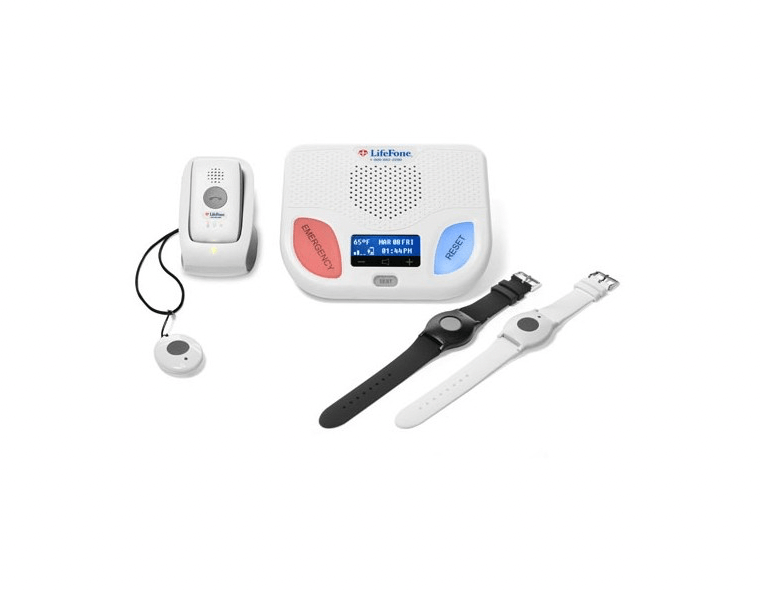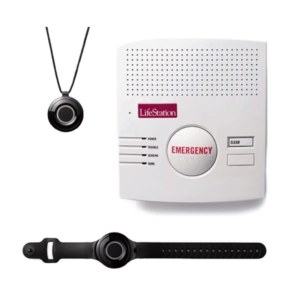LifeFone vs. LifeStation: How They Differ
AgingInPlace.org keeps our resources free by working as an affiliate partner with some companies mentioned on our site. These partnerships or the commission we may earn do not affect our opinions or evaluations of the products we mention. Our reviews are solely based on our research methodology and from input from our AgingInPlace.org Advisory Board. Learn more about our ad policies.
LifeFone vs. LifeStation: How They Differ
Products carousel
When choosing a medical alert system, comparing two different brands might be difficult. They may seem similar on the surface, and it might be hard to tell which one will meet your needs. Seeing a side-by-side comparison between the two brands can help you choose. Here, we’ve compared LifeFone and LifeStation so that you can choose the best one for you.
Key Takeaways
- LifeFone and LifeStation offer some similar services
- LifeFone’s best features are its long battery life and price-lock option
- LifeStation offers fast response times to emergency calls, and a smartwatch-type system is available

LifeFone vs. LifeStation Comparison
LifeFone and LifeStation are two of the oldest medical alert providers. They both offer at-home and on-the-go medical alert systems with various features. However, the systems are not the same. The information below will show you the differences between them.
| Cost & Features | LifeFone | LifeStation |
|---|---|---|
| Monthly cost | $29.95 to $45.95, price guaranteed not to increase | $33 to $47 |
| Up-front fee | None to $39.95 per device chosen | None |
| Activation fee | None | None |
| Contract | Monthly, quarterly, annual plans | Monthly, quarterly, annual plans |
| Call center | USA, 24/7 | USA, 24/7 |
| Optional add-on services | ||
| Fall detection | Fall detection: $5 per month On-the-go fall detection: $10 per month Check-in calls: $19 per month Protection plan: $5 per month | Select and supreme plans only |
| GPS locator | With on-the-go devices | With on-the-go devices |
| Lockboxes | Yes | Yes |
| Wall buttons | Available for an additional fee | Available for an additional fee |
| Extra wearable buttons like pendants or bracelets | Available for an additional fee | Available for an additional fee |
| Spouse monitoring device | Yes | No |
| Cost & Features | ||||||||||||||||||||||||||||||||||||||||||||||||||||||||||||||||||||||||
| Monthly cost | LifeFone | $29.95 to $45.95, price guaranteed not to increase | LifeStation | $33 to $47 |
|---|
| Up-front fee | LifeFone | None to $39.95 per device chosen | LifeStation | None |
|---|
| Activation fee | LifeFone | None | LifeStation | None |
|---|
| Contract | LifeFone | Monthly, quarterly, annual plans | LifeStation | Monthly, quarterly, annual plans |
|---|
| Call center | LifeFone | USA, 24/7 | LifeStation | USA, 24/7 |
|---|
| Optional add-on services | LifeFone | LifeStation |
|---|
| Fall detection | LifeFone | Fall detection: $5 per month On-the-go fall detection: $10 per month Check-in calls: $19 per month Protection plan: $5 per month | LifeStation | Select and supreme plans only |
|---|
| GPS locator | LifeFone | With on-the-go devices | LifeStation | With on-the-go devices |
|---|
| Lockboxes | LifeFone | Yes | LifeStation | Yes |
|---|
| Wall buttons | LifeFone | Available for an additional fee | LifeStation | Available for an additional fee |
|---|
| Extra wearable buttons like pendants or bracelets | LifeFone | Available for an additional fee | LifeStation | Available for an additional fee |
|---|
| Spouse monitoring device | LifeFone | Yes | LifeStation | No |
|---|
LifeFone Overview

As a medical alert system with fall detection, LifeFone offers two large advantages. One is its long battery life; the wearable pendant can last 30 days without recharging. The second is its fee structure, which, regardless of what you start paying per month, will stay the same for the length of the program.
Pros
-
Long battery life
-
Price-lock feature guarantees your price won’t go up while covered
-
Free spousal support
-
Can be purchased without a long-term contract
Cons
-
Add-ons are numerous and can be confusing to choose from
-
Shipping fees have to be paid to return equipment
-
Monthly payments are pricier than other competitors
See our full LifeFone Review.
Different Plans and Models of LifeFone
Plan: $45.95 + $5 per month for fall detection
The At-Home & On-the-Go VIPX system is the most elaborate system that LifeFone offers. The system’s wireless pendant isn’t connected to a base station, and you can add fall detection for $5 a month. Additional apps provide location detection, activity level, and battery life. One negative is that the battery life only lasts 16 days, which is shorter than other LifeFone systems.
Plan: $43.95 (fall detection not available)
The voice-in-pendant system is identical to the VIPX and it does not come with fall detection. It does have a 30-day battery life as most LifeFone systems.
Plan: $39.95 + $10 per month for fall detection
The At-Home and On-the-Go systems combine the features of both types of systems. The base station has a greater range than the At-Home systems, reaching 1,400 feet from the base. A personal emergency care plan is included as well as optional medication reminders, a location feature, and fall detection.
Plan: $34.95 + $5 per month for fall detection
The At-Home Cellular system offers the same features as the At-Home Landline system but works with cellular networks instead of a landline. It provides medication reminders, a feature the landline system does not have.
Plan: $29.95 + $5 per month for fall detection
The At-Home Landline includes a base station with a two-way speaker and a wearable button. Its range is 1,300 feet from the base system and has a room temperature detection feature that will notify you if the temperature goes above or below a certain level. Automatic fall detection and a waterproof button are also available.
LifeStation Overview

LifeStation’s biggest feature is its monitoring system. There are two different monitoring centers for customers, which claim to have one of the quickest response times of all personal emergency response systems. Since quick response times are associated with better outcomes in certain crucial cases, this can be reassuring.
Pros
-
Monitoring centers have one of the fastest response times in the system—only 20 seconds
-
Monitoring centers have won awards
-
Smartwatch-type device available
Cons
-
Pricing information is not easy to find
-
Only 600-foot range for at-home systems
-
Pendants and wristbands are large and can be uncomfortable to wear
See our full LifeStation Review.
Different Plans and Models of LifeStation
Plan: $32.95 per month
LifeStation’s at-home system consists of a base station connected to either a landline or a cellular network and a wearable pendant and wristband. Its coverage is 600 feet from the base. Once the emergency button is pressed, an operator will stay in contact with you until help arrives, while another operator will call for help.
Plan: $37.95 per month
The LifeStation Sidekick is a rechargeable, water-resistant pendant with GPS location technology and available fall detection
Plan: $43.95 per month
The Sidekick Smart is a wristband that resembles a smartwatch. Besides the help button, it contains fall detection, GPS location tracking, a step counter, and heart rate monitoring. Like a smartwatch, it also displays the time.
Similarities and Differences between LifeStation and LifeFone
Both LifeFone and LifeStation offer at-home systems that can be connected to a landline or cellular network and on-the-go plans that can be used outside the home. Fall detection is available on all LifeStation plans and all LifeFone plans besides the voice-in-pendant. This is a crucial feature since falls are one of the greatest risks to a senior’s health.
One of the biggest differences between the two systems is their at-home range. LifeFone can give you as far as 1,400 feet from the base, while LifeStation is limited to 600 feet. While both offer GPS medical alert systems, LifeStation offers a wristband like a smartwatch with heart rate monitoring and a step counter, while LifeFone’s system is a two-way voice-activated pendant with some other features.
What Customers Are Saying about Both Brands

LifeFone
“This company has the very best customer service reps … I switched from another company and the difference is like day and night. The care you have for your customers has the feeling coming right through the telephone. I fell on the tile floor and hit my head very badly, etc … and within a very short time, and I did NOT press the button at all, the fall detection feature came thru and the rep was speaking to me … How very wonderful because if I did not have this and became unconscious, I probably would not be here to thank you! You are the BEST!!!” –Naomi M., Trustpilot
“I had a different device but LifeFone had much better qualifications so we decided we needed a changeover, which I’m very pleased about. I’ve been really lucky in that I haven’t had to use it too often, but it’s there and it’s good knowing that it will work if I need it. I don’t think anyone can beat this one, I recommended it wholeheartedly to everyone.” –Evalena, Best Company
LifeStation
“Good quality service. Convenient device for my 92 year old grandpa. Quick response to call and fall detection. Had some issues with fall detection and got great support. I recommend this device.” –Kirby M., Trustpilot
“The customer service has been very helpful over the years that we’ve had them. I like the demeanor of the individuals that answer the phone and their ability to be calm in a crisis. I just got through testing the device and it did take a little bit of time for them to answer it. In fact it stops saying ‘emergency’ and then we have to wait for somebody to answer or pick up but I did have to use it for a number of falls and a stroke for my mom. Overall, it’s been great.” –Mary, Best Company
Bottom Line
There’s no clear winner if you’re considering choosing between LifeFone and LifeStation. Some users may prefer the fast response time and the smartwatch-type option that LifeStation offers, and some may be more comfortable with the generous at-home range and long battery life that LifeFone can give you. Because of its price-lock feature, LifeFone has a clear advantage in overall costs.
Why Trust Us
Our Aging In Place medical alert experts independently research and recommend products we believe provide value in the lives of our readers. We’ve spent more than 1,700 hours collectively conducting in-depth research on medical alert systems. Throughout this process, we did the following:
- Engaged in ongoing independent research
- Consulted with geriatricians and adult caregivers
- Mystery-shopped the brands
- Surveyed medical alert system users
- Tested various medical alert systems
Frequently Asked Questions
-
LifeFone’s cellular service is provided by AT&T or Verizon, depending on what is available in your area.
-
LifeFone plans start at $29.95 per month, but they can go up to $45.95 a month.
-
LifeStation plans start at $32.95 per month, but they can go up to $43.95 per month.
-
LifeFone offers a landline-based plan, but it also offers cellular plans for those who don’t have a landline.
-
All LifeFone buttons are either water-resistant or available in a water-resistant option.
Pricing is accurate as of April 20, 2022.
WRITTEN BY
Annie Keller is a freelance medical writer in Lowell, Mass. She has worked for a variety of medical publications and organizations. She has written about chronic illness, medical technology and devices, medical issues in the news, skin treatments, sports medicine, and many different conditions.
View AuthorDo you want to cite this page? Use our ready-made cite template.




